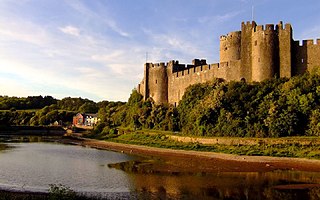Related Research Articles

Pepin II, commonly known as Pepin of Herstal, was a Frankish statesman and military leader who de facto ruled Francia as the Mayor of the Palace from 680 until his death. He took the title Duke and Prince of the Franks upon his conquest of all the Frankish realms.

Hugh Capet was the King of the Franks from 987 to 996. He is the founder of and first king from the House of Capet. The son of the powerful duke Hugh the Great and his wife Hedwige of Saxony, he was elected as the successor of the last Carolingian king, Louis V. Hugh was descended from Charlemagne's son Pepin of Italy through his mother and paternal grandmother, respectively, and was also a nephew of Otto the Great.

The Carolingian dynasty was a Frankish noble family named after Charles Martel and his grandson Charlemagne, descendants of the Arnulfing and Pippinid clans of the 7th century AD. The dynasty consolidated its power in the 8th century, eventually making the offices of mayor of the palace and dux et princeps Francorum hereditary, and becoming the de facto rulers of the Franks as the real powers behind the Merovingian throne. In 751 the Merovingian dynasty which had ruled the Franks was overthrown with the consent of the Papacy and the aristocracy, and Pepin the Short, son of Martel, was crowned King of the Franks. The Carolingian dynasty reached its peak in 800 with the crowning of Charlemagne as the first Emperor of the Romans in the West in over three centuries. Nearly every monarch of France from Charlemagne's son Louis the Pious till the penultimate monarch of France Louis Philippe have been his descendants. His death in 814 began an extended period of fragmentation of the Carolingian Empire and decline that would eventually lead to the evolution of the Kingdom of France and the Holy Roman Empire.

Arnulf I, called "the Great", was the first Count of Flanders.
Arnulf de Montgomery was an Anglo-Norman magnate. He was a younger son of Roger de Montgomery and Mabel de Bellême. Arnulf's father was a leading magnate in Normandy and England, and played an active part in the Anglo-Norman invasion of Wales in the late eleventh century.

The term Nibelung (German) or Niflungr is a personal or clan name with several competing and contradictory uses in Germanic heroic legend. It has an unclear etymology, but is often connected to the root Nebel, meaning mist. The term in its various meanings gives its name to the Middle High German heroic epic the Nibelungenlied.

Gertrude of Nivelles, OSB was a seventh-century abbess who, with her mother Itta, founded the Abbey of Nivelles, now in Belgium.
The Pippinids and the Arnulfings were two Frankish aristocratic families from Austrasia during the Merovingian period. They dominated the office of mayor of the palace after 687 and eventually supplanted the Merovingians as kings in 751, founding the Carolingian dynasty.

Vrak was a Canadian French language specialty channel owned by Bell Media. The channel primarily broadcast live-action programming aimed at 13-to-35 age group audiences. Launched in 1988 as Le Canal Famille, the channel ceased operations on October 1, 2023, due to declining viewership and it being deemed "outdated" by Bell Media.
Ernoul was a squire of Balian of Ibelin who wrote an eyewitness account of the fall of Jerusalem in 1187. This was later incorporated into an Old French history of Crusader Palestine now known as the Chronicle of Ernoul and Bernard the Treasurer, often abbreviated Ernoul-Bernard. The chronicle covers the years from 1100 until 1228. A few manuscripts copied for Bernard, treasurer of Corbie Abbey, extend the narrative down to 1232.
Childebrand I was a Frankish duke (dux), illegitimate son of Pepin of Heristal and Alpaida, and brother of Charles Martel. He was born in Autun, where he later died. He married Emma of Austrasia and was given Burgundy by his father, becoming a duke. He distinguished himself in the expulsion of the Saracens from Francia alongside his brother when he captured Marseille, one of the largest cities still in Umayyad hands.

The Chronicle of Fredegar is the conventional title used for a 7th-century Frankish chronicle that was probably written in Burgundy. The author is unknown and the attribution to Fredegar dates only from the 16th century.

The siege of Avignon was contested in 737. Frankish forces led by Charles Martel defeated the Umayyad garrison of Avignon and destroyed the stronghold.
Ansbert was a Frankish Austrasian noble, as well as a Gallo-Roman Senator. He is thought to be the son of Ferreolus, Senator of Narbonne and his wife, Dode. This would make him the great-grandson of Tonantius Ferreolus, Praetorian Prefect of Gaul and his wife Papianilla.

Gerald de Windsor, aliasGerald FitzWalter, was an Cymro-Norman lord who was the first Castellan of Pembroke Castle in Pembrokeshire. Son of the first Norman-French Constable of Windsor Castle, and married to a Welsh Princess daughter of the King of Deheubarth, he was in charge of the Norman forces in south-west Wales. He was also steward and governor for the Norman magnate Arnulf de Montgomery. His descendants were the FitzGerald dynasty, as well as the FitzMaurice, De Barry, and Keating dynasties of Ireland, who were elevated to the Peerage of Ireland in the 14th century. He was also the ancestor of the prominent Carew family, of Moulsford in Berkshire, the owners of Carew Castle in Pembrokeshire and of Mohuns Ottery in Devon.

Arnoald, also called Arnoldus or Arnual, was a Bishop of Metz between 601 and 609 or 611, the successor of his uncle Agilulf. He was the son of Ansbertus, a senator, and his wife Blithilde, whose parents were Charibert I and Ingoberga.
Humphrey de Vieilles was the first holder of the "grand honneur" of Beaumont-le-Roger, one of the most important groups of domains in eastern Normandy and the founder of the House of Beaumont. He was married to Albreda or Alberée de la Haye Auberie.
Maad Ndaah Njemeh Joof is one of the patriarchs of the Joof family, himself the medieval King of Laah in Baol now part of independent Senegal. He ruled from the late 13th century to the early 14th century, c. 1290. His descendants from the branch of Maad Patar Kholleh Joof ruled the pre-colonial Kingdoms of Sine, Saloum and Baol, from the 14th century to 1969. The last king of Sine and Saloum died in 1969. After their deaths, the Serer States of Sine and Saloum were incorporated into independent Senegal. His descendants went on to found three royal houses:
Auda, Aida, Alda, Aldana or Adalne was wife of Frankish nobleman Thierry IV, count of Autun and mother of Saint William of Gellone.
Count Nibelung or Nevelung, son of Count Ricfried and his wife Herensinda. He was probably his father's heir, and like his father he was probably a count in Betuwe (Batavia), and more generally in the Rhine-Meuse-Scheldt delta region, now in the Netherlands, and the neighbouring northern Rhineland in Germany. His better-known brother was Bishop Balderic of Utrecht.
References
- Levillain, L. "Les Nibelungen historiques et leurs alliances de famille." Annales du Midi, 49 (1937) 337–407.
- Riché, Pierre. Les Carolingiens, une famille qui fit l'Europe. 1983.
- Le Jan, Régine. Famille et pouvoir dans le monde franc (VIIe-Xe siècle). Publications de la Sorbonne: Paris, 1995.